How to set yourself up for a successful game localization project
Getting ready to localize your game? Learn what to consider before starting a localization project, from setting up your file to creating a style guide.

Let’s discuss what parts of your game you can localize and how it affects your game localization costs.
Besides translating in-game text, you can also localize the description, updates, and keywords if you release your game on platforms like the Apple App Store, Google Play, or Steam.
Additionally, consider translating marketing and advertising materials if you plan to promote your game extensively.
The game localization process can be categorized into:
Localizing the app store description is crucial, as it is the first thing users see and influences their decision to buy or download your game.
A 2020 survey by CSA Research, implemented on 8,709 consumers in 29 countries, found that 76% prefer purchasing products with information in their own language. Notably, given the choice between buying two similar products, 94% participants from Taiwan, 92% from Korea, 92% from China, 90% from Japan, and 88% from Indonesia will choose the one with information in their language.
All text surrounding your description will be in the country store’s official language (Google and Apple fully localize their stores) so translated material will blend with the official store text and create a professional impression.
Wondering if you should translate the in-game text too?
With worldwide distribution, game localization expands your reach and appeals to a global audience. Letting players enjoy your game in their language enhances their experience and boosts positive reviews.
Of course, these benefits need to be considered against the cost.
>> Learn more about localization strategies for popular game genres
The expenses associated with game localization depend on factors such as the word count in your game, the languages you are targeting, and the rates for translation services.
The cost of game translations performed by human linguists will depend on the language. These can start with as little as 0.11 EUR per word. Proofreading usually costs 50% of the translation rates. These are the LocalizeDirect rates but it gives you an idea about approximate prices in the market.

Quality of the translation is an important factor - Human revision of machine translation may lead to unexpectedly higher costs if the quality of the machine translation is very low. In such cases, the revision process might transform into a full retranslation, causing increased costs, delays, and ultimately yielding lower quality compared to what could be achieved with a fully human translation of crucial game text from the outset.
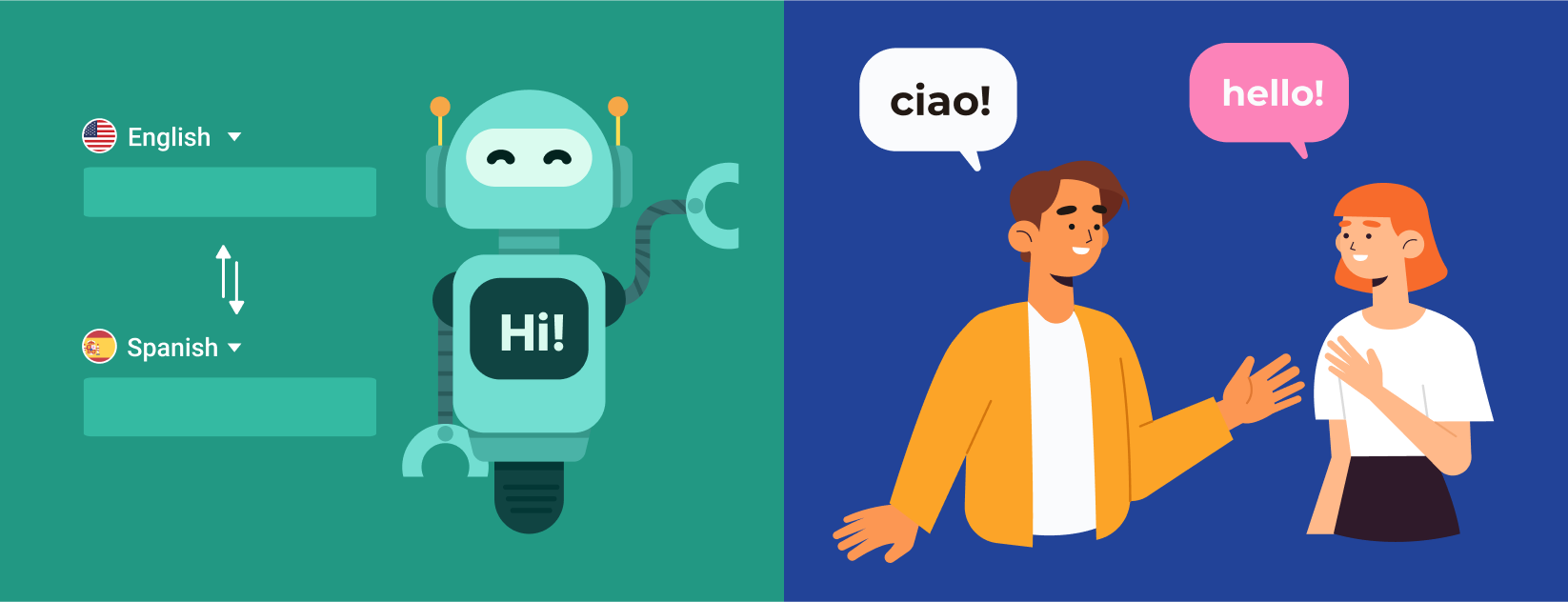
A common approach is to translate the app-store metadata into more languages than the actual game. Have no fear, as the amount of text in your description is limited, translation shouldn’t be too expensive.
When it comes to the in-game content, it all depends on how “wordy” your game is. Analyzing the past six months, a significant portion of our game clients (translating over 2.5k words) opted for 5-9 languages. Surprisingly, an almost equal large group chose to localize in 10 or more languages. The smallest group placed orders for below 5 languages. On average, our game clients kick off with 7-10+ foreign languages when localizing their in-game text.
When it comes to localizing updates, take into account the frequency of your release schedule. It is advisable to consistently engage the same translation service provider, ensuring uniformity not only in terms but also in style and the overall “feel” of your game. It’s most beneficial to continue working with translators familiar with your game.
When selecting the markets and languages for localization, ask yourself a few questions:
You need this information to understand the potential of your game and how it matches the opportunities of the market you are about to target.
A big factor is also what expectations certain countries have.
In France, Germany, Spain and Asian countries such as Japan, gamers expect full VO, especially on big titles.
Regarding Polish, the sentiment remains largely accurate, as comprehensive Polish voiceovers are primarily offered by major industry players like Sony and Bethesda (not exclusively, but notably).
In some non-native English speaking countries, gamers don’t mind playing games in English at all. Especially if the amount of text is minimal or the concept of the game is a familiar one.
Pro Tip: Check the language specifications in T-Index or the EF English Proficiency Index. It can be of use to know which countries most probably won’t accept the unlocalized game at all (with low and very low English proficiency skills).
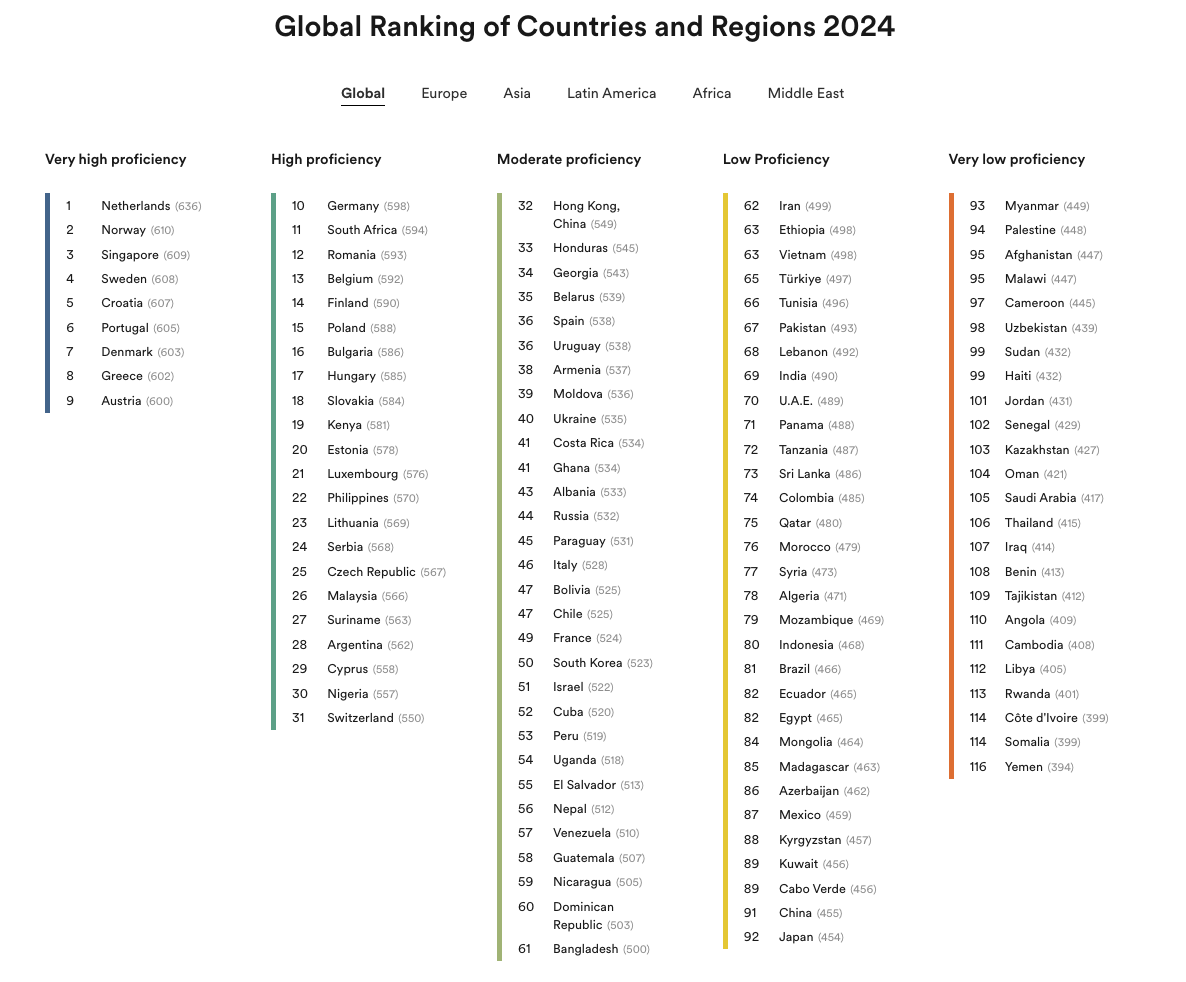
Countries ranked by English proficiency skills (EF EPI 2024).
Review the most popular games in various markets to evaluate the competition and audience preferences.
Pro Tip: You can find information about mobile games in App Annie’s reports. SimilarWeb is another free tool with plenty of functionality for this purpose. Steam publishes real-time data about its top 100 PC games by player count and the most demanded languages.
Some key metrics game developers should pay attention to are downloads and revenue rates specifically for games. Most developers would share the common goal of wanting to get their game downloaded as many times as possible or generate as much revenue as they can.
For the potential revenue stream and amount of players you can reach, go through the games reports regularly published by Newzoo.
As of 2023, there were 3.22 billion gamers worldwide, according to Newzoo. The market was estimated to generate $187.7 billion in 2023, representing a +2.6% year-on-year growth despite challenging macroeconomic factors
Newzoo forecasts that the mobile games market will account for $113 billion in revenue by 2024, compared to $67.7 billion for consoles and $41.9 billion for PC. By 2024, it is anticipated that there will be 3.32 billion gamers worldwide.
In the latest report from Statista, which highlights the leading gaming markets worldwide and was released in August 2023, the top 10 countries producing the maximum game revenue include the United States, China, Japan, South Korea, the United Kingdom, Germany, France, Canada, Australia, and Italy. These 10 countries accounted for 50% of global revenue, which is estimated at almost $347 billion USD
According to Newzoo, in 2022, the top 10 markets and countries by revenues were the United States, China, Japan, South Korea, Germany, the United Kingdom, France, Canada, Italy, and Brazil. Together, these 10 countries generated nearly 78% of the global revenue.
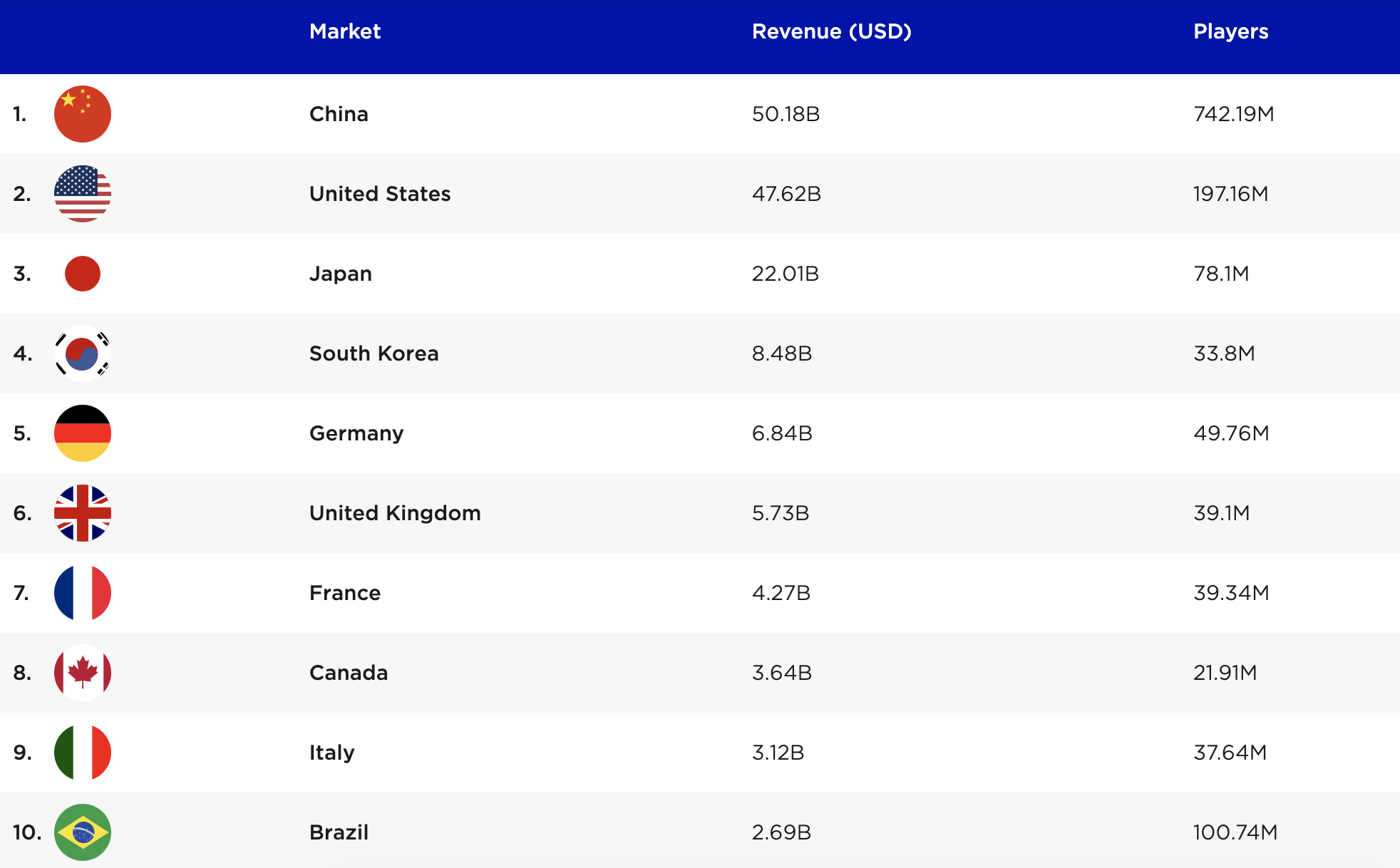
Top 10 Countries/Markets by Game Revenues in 2022 (Newzoo)
Although the estimation and measurement methods for global revenue may differ between the two, the top 10 leading markets are quite similar. Hence, expanding into these markets with a localization strategy can significantly boost your player base, leading to increased sales, revenue, and profitability.
According to Newzoo, as of 2023, the Asia-Pacific region contributes 46% of the global games market revenue, while North America generates 27% of the global game market revenue.
If your monetization model relies on ads, it’s reasonable to consider localization in Asia-Pacific countries such as India, China, Japan, and South Korea, as players from this region account for 53% of global players, with a year-on-year growth rate of 5.7%, according to the Newzoo report released
Not really.
Having your game in English will allow you to reach North American, Australian, British, part of the Indian and some other Asian markets. You may want to also look at separate British and American versions. It can irk if the player finds words that aren’t local or expected. If they are game genre specific then this is fine, however many are not.
Pro tip: If you’ve written your game in English but are not a native English speaker, it’s highly advisable to undergo English proofreading for your game text. This ensures that the text sounds genuinely native, natural, conveys the intended message, and offers a high level of immersion.
Robust English serves as a crucial foundation for subsequent game localization into other languages, making an investment in this foundation a time-saving, cost-effective measure that enhances the quality of localization into other languages as well.
Now, let’s have a look at the most popular languages we localized games into in 2023 in terms of word count. In total, the data pool includes 33 languages.
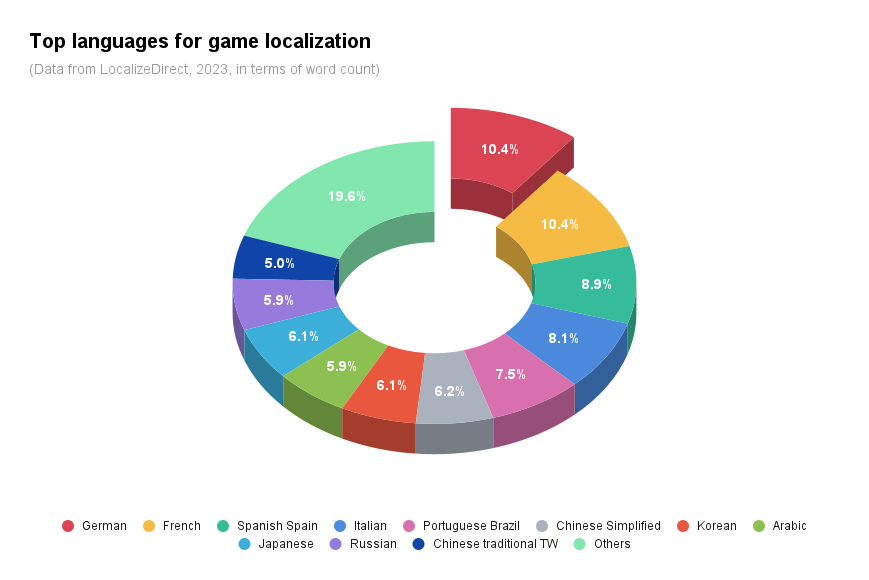
More than one-third of the localization orders we receive fall into four languages, so-called FIGS: French, Italian, German, Spanish.
Then we have Brazilian Portuguese, Simplified Chinese, Korean, Arabic, Japanese, Russian and Chinese traditional TW.
They are followed by Turkish, Polish, Spanish LATAM, Dutch, Swedish and Thai.
Again, the first 10 languages made over 80% of the overall word count pool.
The majority of the game development companies based in Europe or North America select FIGS + PT + RU as the primary choice while Asian game studios and publishers prefer CJK as the first wave in their localization process.
Our must-have list includes FIGS+ZH+PT+RU. And here’s why.
France is the 7th largest video game market based on the 2022 generated video game revenues (Newzoo). Another reason to localize games to French is the large number of countries and claim French as their national language. As well as France, it opens the door to Belgium and Switzerland. Besides that, 27 other countries largely in Africa have native French speakers.
Italian is officially spoken in Italy, Switzerland and San Marino. Italy is the 9th largest gaming market in the world. It has grown accustomed to high-quality game localizations due to the low English penetration rates.
German secured the top position multiple times consecutively in the annual game localization ranking by LocalizeDirect. With German, you’ll be able to reach German and Austrian gamers, as well as those in Switzerland, Luxembourg and Lichtenstein.
Spain’s gaming market is fairly small - 27 million. However, if we consider Spanish speaking internet users we’re talking about a whopping 363 million - the third largest cluster after English and Chinese. Given the dominance of the United States in the rankings and that 18.5% of the population in the US is Hispanic (60.6 million), it’s no surprise why many developers decide to translate games to Spanish.
Important: Latin American Spanish is different from European. Nevertheless, in South America, a game in any Spanish is welcomed more than just an English version. We recommend using Spanish Spain for Europe and LATAM for the Americas; the differences are quite substantial.
Localization into Chinese often requires game culturalization. Google Play Store is banned in mainland China and replaced by the local Android stores. If you use other mobile app stores (like Amazon or Tencent) then we recommend translating your game into Simplified Chinese too.
Important: Publishing your game in Hong Kong or Taiwan, you’ll need to translate your game into Traditional Chinese (local versions).
By the way, Chinese is the second most popular language on Steam, followed by Russian. Bare it in mind if you prepare your PC game for Steam.
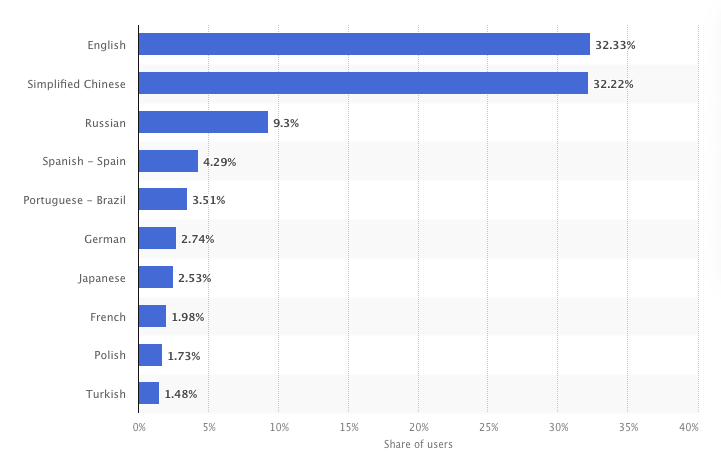
Most common main languages on Steam, October 2023
It allows you to reach half of the Latin American continent and one of the most populated emerging economies - Brazil. Please, do not reuse your European Portuguese translations - here we explain why.
Russian serves as a lingua franca in Russia, Kazakhstan, and Belarus, with approximately 258 million Russian speakers worldwide (as per UNRIC). While English is widely acknowledged as a global lingua franca, it’s important to note that a significant segment of the Russian population lacks fluent English proficiency.
Finally, let’s examine the languages that demonstrated the highest growth over the seven-year period from 2015 to 2022.
According to LocalizeDirect’s internal data, certain languages experienced a significant surge in orders. Ukrainian and Thai exhibited a growth rate increase of 6x, followed by Malaysian, Czech, and Arabic, each showing a 5x increase. Additionally, Greek, Tagalog, Romanian, Hindi, Vietnamese, and Indonesian demonstrated a 4x growth.
During the same period, Hungarian and Slovakian also joined the ranks of the fastest-growing game localization languages. The increased demand for Hungarian and Slovakian services can be attributed to the emergence of these two markets.
Statista predicts that the Video Games market revenue in Hungary is expected to reach US$198.70 million in 2024, with a projected annual growth rate (CAGR 2024-2027) of 9.87%. This growth is anticipated to lead to a market volume of US$263.50 million by 2027. User penetration is forecasted to be 15.4% in 2024 and is expected to increase to 17.1% by 2027.
In Slovakia, the Video Games market is forecasted to achieve a revenue of US$107.50 million in 2024, with an anticipated annual growth rate (CAGR 2024-2027) of 6.07%. This growth is poised to result in a projected market volume of US$94,490.00 million by 2027. The projected user penetration is 9.5% in 2024 and is expected to rise to 10.5% by 2027.
In addition to the already substantial languages of Simplified Chinese, Japanese, and Korean, emerging gaming markets in Asia, including Thai, Vietnamese, and Malaysian markets, among others with a considerable gamer population, are garnering interest in the gaming industry, and this upward trend is expected to continue.
Having your game translated into “traditional” European + Asian languages is always a safe bet. However, stepping into emerging markets now may be a reasonable move for further expansion. If you’re ready to make a strategic move towards global expansion, reach out to us. Share your inquiries, and let’s start a conversation about how we can tailor a localization plan specifically for your game.
Getting ready to localize your game? Learn what to consider before starting a localization project, from setting up your file to creating a style guide.
Some Asian countries are absolute global leaders in the gaming industry: for instance, China, Japan, and South Korea are all in the top 4 by revenue after the US. Other markets (Southeast Asia and the Middle East) are some of the most rapidly growing ones, especially in the sector of mobile gaming.